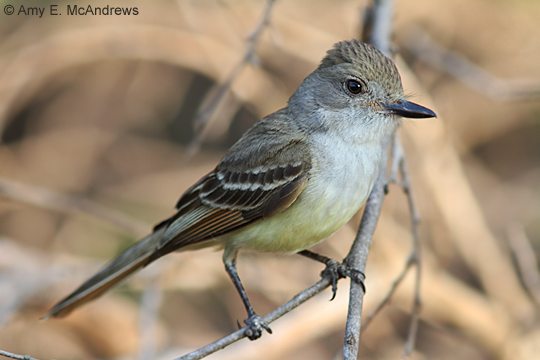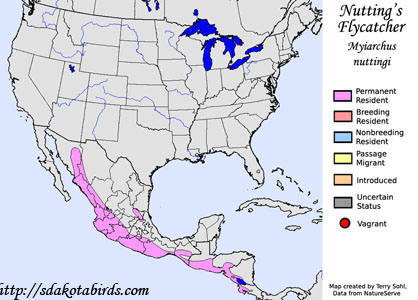| Length: 7.25 inches | Wingspan: 12 inches | Seasonality: Non-resident in South Dakota |
| ID Keys: Grayish-brown upperparts, light gray chest, pale yellow belly, rufous on tail and outer webs of wing feathers, two light wing-bars | ||
 The
Nutting's Flycatcher is yet another of the very similar Myiarchus
flycatchers. However, while the similar
Ash-throated Flycatcher,
Brown-crested Flycatcher,
and Dusky-capped Flycatcher
all have normal home ranges in at least part of the United States, the
Nutting's Flycatcher is normally found south of the border, in Mexico and
Central America. They are vagrants in the United States, having been
confirmed a handful of times in southern Arizona and California.
The
Nutting's Flycatcher is yet another of the very similar Myiarchus
flycatchers. However, while the similar
Ash-throated Flycatcher,
Brown-crested Flycatcher,
and Dusky-capped Flycatcher
all have normal home ranges in at least part of the United States, the
Nutting's Flycatcher is normally found south of the border, in Mexico and
Central America. They are vagrants in the United States, having been
confirmed a handful of times in southern Arizona and California.
Habitat: Found in a tropical deciduous forest, thick shrublands, and semiopen habitats with scattered dense shrubs or trees.
Diet: Feeds on insects and spiders, but will also take small fruits and berries.
Behavior: Foraging is done by observing from a perch and flying out to capture insects that it spots. Insects are gathered by hovering briefly and gleaning insects from the surface of foliage or branches, or sometimes by capturing insects in mid-air.
Nesting: The nest of a Nutting's Flycatcher is built in a cavity in a tree (or sometimes a man-made object like a post or telephone pole), and consists of twigs, grasses, weed stems, roots, feathers, and other material. The female usually lays 3 or 4 eggs, and she alone incubates them. When the eggs hatch, both parents help to raise the young.
Song: The call of a Nutting's Flycatcher, a crisp wheet sound, is the best means of differentiating the species from the similarly plumaged species mentioned below.
Migration: Considered a permanent resident in its normal range in Mexico and Central America.
Interactive eBird Map: Click here to access an interactive eBird map of Nutting's Flycatcher sightings
Similar Species: Very similar in appearance to several other flycatchers with yellowish bellies that are found in the southwestern United States, including Brown-crested Flycatcher, Ash-throated Flycatcher, and Dusky-capped Flycatcher.
Conservation Status: Populations are found over a wide geographic area and appear to be stable. The IUCN lists the Nutting's Flycatcher as a species of "Least Concern".
Further Information: 1) BirdLife International - Nutting's Flycatcher
2) Whatbird - Nutting's Flycatcher
3) Phainopepla Fables - Nutting's Flycatcher
Photo Information: Photo taken by Amy McAndrews - May 7th, 2011 - Isthmus of Tehuantepec, Oaxaca - Photo licensed under Creative Commons Attribution NonCommercial NoDerivs 2.0 Generic License.
| Click below for a higher-resolution map |
 |
| South Dakota Status: Non-resident in South Dakota |
Additional Nutting's Flycatcher Photos (coming soon!!)
